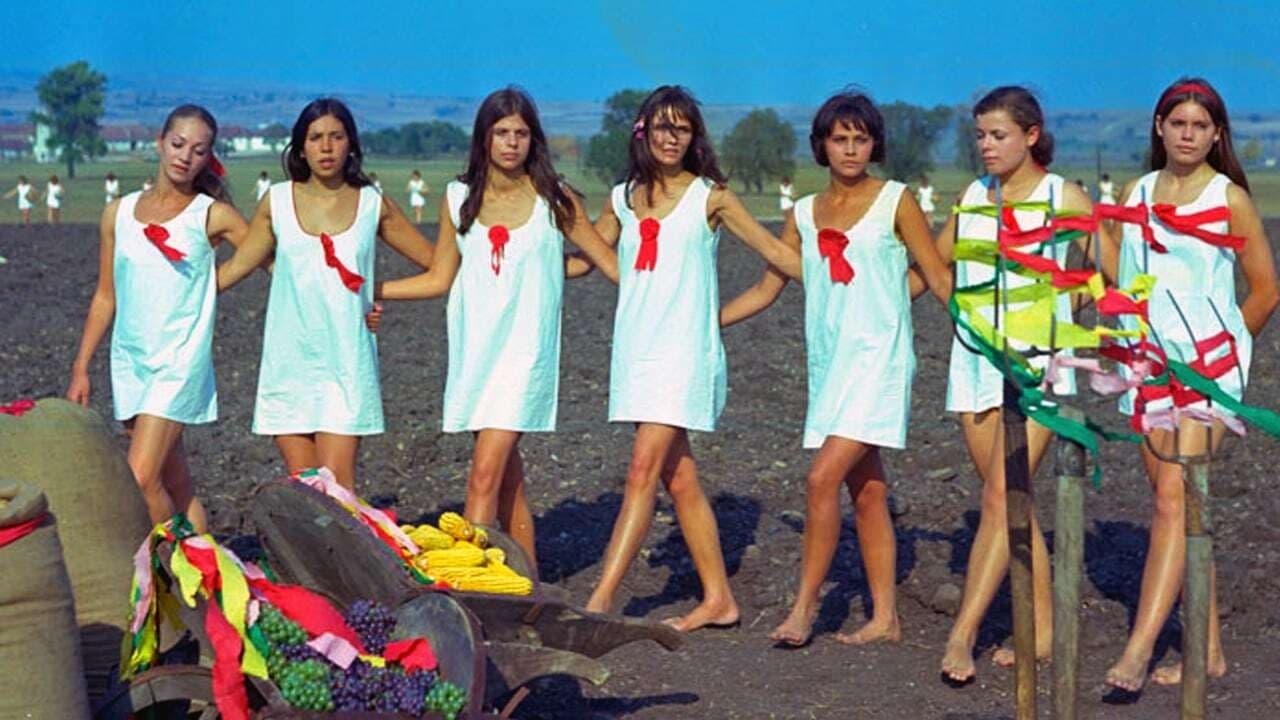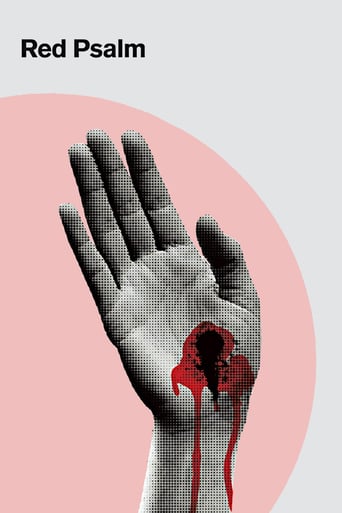



Plot so thin, it passes unnoticed.
This is an astonishing documentary that will wring your heart while it bends your mind
View MoreClose shines in drama with strong language, adult themes.
View MoreBlistering performances.
It was the first time i encounter a Hungarian filmmaker when i watched, by mistake Red psalm.The movie surprised me on many layers Beyond all the expectations that i had before i watched it: An exceptional treatment of the image and the cinematography. With only 27 cuts, Jansco manages with his moving camera and his choreographed scenes to tell a story that is so transparent, so poetic, and so close to the heart.A small group of farm workers, some songs and some rifles, thats all what took jansco to make a fascinating movie, although one can argue that the communist manifestation in the movie is direct, but one must not forget the environment and the mentality through which a group of farm workers in a simple field in the Hungarian countryside may accept or refuse a way of thinking and of acting, the thing that the director was aware of completely.The dancing, the songs, the movements, and the theatrical monologues, all in all , even the name , "Red Psalm" and its sweet resonance in the ear as much as the movie is pleasing for the eye, all those factors make the movie rather a sweet love poem, a piece of poetry that teaches love, revolt and solidarity, Chapeau Mr. Miklos !
View MoreHow does one go about describing this movie? Odd? Bela Tarr before Bela Tarr. Boring. Without a doubt. Definitely not for the mainstream cinema goer but is it also for the art house lover? Only a hard-core alternative cinema can love this movie. But can you appreciate it? sure. Roving cameras. Complex rhythms and sudden breakouts into song and dance, yet there is nothing musical about it. It is first and foremost a mood piece. To understand it, you really need to know the background of the opus. This might be considered a spoiler."According to film critic, Raymond Durgnat, the movie is based on a series of psalms, thus the title, and prayers written circa 1890. They are of a socialist nature echoing such biblical models as the Lord's Prayer."END OF SPOILERKnowing the background, the movie makes sense as a series of short stories, each ending with the same thematic resolution. A socialist parable for chaotic times. It was the seventies after all. Using a kind of folk narrative medium, kind of like performing in the village square for the elders, it possesses an African or European medieval story telling technique. Hard to follow, except as a tale of the lower classes versus the aristocracy and tyranny, it is something short of a dictum for revolution. Refusing to explain itself, it comes across as live theater packed with heavy symbolism. There is blood and lots of it. Gun shots and death. Camaderie, community, resistance, nakedness of the soul and death. Rambling in circles, at times, it is laughable; sprinkled with unusual sound edits, curious performances and image synching. But it is all controlled by the invincible hand of Jancso who orchestrates the mise-en-scene like a virtuoso marionettist. Tricky, intricate camera movements supposedly done in 28 shots make up the movie. It is a ballet of zoom lenses curious camera set-ups and resistance to the basic nature of its medium. Neither here or there on the engrossing meter scale, it does present experimental cinema and a different film vocabulary. Championed by some wayward critics over the years, it did win the best director at the Cannes film festival. So that is what you get. Limited story, confusing actions and narrative arc in a stop and go fashion but camera tricks comparable to the best of Fellini. PS. I saw the movie on the big screen but the projectionist framed it to look like a big TV screen. It looked odd. I have no idea if this was the original framing.
View MoreIn the book “1001 Movies You Must See Before You Die” eminent film critic Jonathan Rosenbaum wrote about RED PSALM being “…dazzling…awesome…ravishing…striking…it may well be the greatest Hungarian film of its time…”; conversely, Miklos Jancso'’s acknowledged masterpiece THE ROUND-UP (1965) – which I adore – is conspicuous by its absence in that singular pantheon. Besides, the late great film critic Raymond Durgnat wrote extensively about this film in his very last article published in 2002. Furthermore, Jancso' won the best direction prize at the Cannes Film Festival when Joseph Losey (whom I admire a great deal) was the President of the Jury and where RED PSALM was competing against such remarkable contenders as Robert Altman’s IMAGES, Harry Kumel’s MALPERTUIS, Peter Medak’s THE RULING CLASS and Andrei Tarkovsky’s SOLARIS! Why is it, then, that my star rating is such a lowly one? There is no doubt in my mind that this is a key work in the director’s canon (which makes my underwhelmed reaction all the more painful to me) but, frankly, this is truly a case where form completely overpowers content or, to put it in the apposite layman’s terms, a film which can only be admired but not enjoyed. The main reason for this is that the entire running time (a relatively modest 81 minutes in PAL mode) is taken up by Jancso'’s obsession with politics and folklore with no space left for any real characters to emerge much less a discernible plot line. This would hardly be a problem in itself where it not for the fact that when somebody takes a break from the constant – and by now familiar – communal dancing marathons (which, thankfully, does mean that some of the typically stunning girls get to shed their clothing), they do so only to spout a litany of Communist diatribes which completely wear the viewer (and the film itself) down before long. Although Jancso'’s exuberant visual style always had a certain aloofness to it, I really didn’t connect at all with any of the characters or events depicted here. In fact, I’d go so far as to say that this is one time where the English subtitles (which, in themselves, are grammatically awkward and replete with spelling mistakes) distinctly felt like an intrusion and their verbosity detracted from the power of the meticulously composed images. Consequently, one’s enjoyment of the film as a whole suffers for it and given the generic, prosaic nature of the dialogue, I might well consider watching the film unsubtitled in the future! Amusingly enough, however, the Catholic prayer of Our Father is even blasphemously transformed into a Communist credo at one point.Still, this is not to say that the film is completely worthless: the rebelling peasant farmers sing various songs (a couple of which are in English) that, while lyrically are merely propagandistic, are also melodically haunting. Given Jancso'’s penchant for lengthy, traveling sequence-shots (the film is said to contain a mere 26 in all!) which are, essentially, its true raison d’etre, some striking images can’t help but stand out, in particular the burning of a church by the peasants and their eventual massacre by the landowners’ army of defenders. Even more remarkable is Jancso' fusing his historical recreation with unexpected but decidedly welcome fantasy elements which sees dead people coming back to life with a kiss and, in an unheralded uproar to which nobody retaliates, an incensed peasant woman shoots several soldiers in quick succession single-handedly, etc.As a result of my disappointing viewing of RED PSALM, I have decided to to take a sabbatical from Jancso' for now and postpone the three other films of his that I have in my possession to a later date (by which time, nevertheless, hopefully I would have acquired two more)…
View MoreI saw this three times on the same evening as a teenager at UC Santa Cruz, which claimed at the time (this was before DVDs) to have the only existing print in the United States; this is almost 20 years ago now, but I still remember being -- if not exactly entranced, at least lulled, by Jancsó's restless, dancing camera, and the underground pulse of menace that pushed and shaped the actors' dancing. It takes place on a great plain or meadow, I think; and there's a cast of what seems to be a hundred dancers, dancing in the circle-dances not unlike the end of Bertolucci's "Last Tango In Paris," Communism and film form all one. The shots are long and languid, like Bela Tarr: there's something like 17 edits in the entire 90 minute film. And the last image is still seared on my mind's eye: a beautiful woman slits her palm with a knife, holds it to her breast, and then faces the camera, showing us her wound: instead of blood, a red scarf is tied around her hand, a banner that combined with her defiant pose speaks revolution, the red psalm of the title.
View More